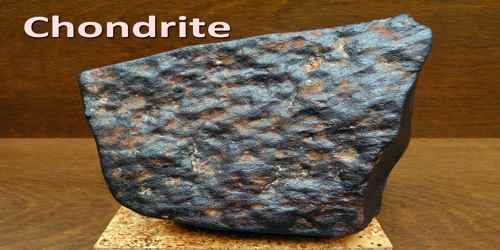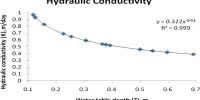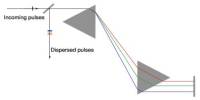Chondrite
Definition
Chondrite is a stony meteorite that contains chondrules embedded in a fine matrix of the silicate minerals olivine and pyroxene. About 85 percent of all meteorites are chondrites. One of their characteristics is the presence of chondrules, which are round grains formed by distinct minerals that normally constitute between 20% and 80% of a chondrite by volume.
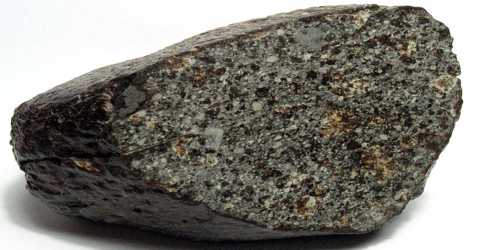
Scientists believe that chondrites originated from the asteroids that orbit the sun between Mars and Jupiter during the early stages of the solar system. They account for up to 86 percent of all meteorite landings, with achondrites making up the remaining 14 percent. Chondrites are the most primitive of all asteroids, and they consist largely of calcium/aluminum inclusions (CIA). Many chondrites feature grains called stardust that pre-date the solar system that formed in supernovae or from other suns. They vary greatly in their composite structures according to where in the solar nebula they formed, and how many heating and cooling cycles they have undergone throughout their existence.
There are currently over 27,000 chondrites in the world’s collections. The largest individual stone ever recovered, weighing 1770 kg, was part of the Jilin meteorite shower of 1976. Chondrite falls range from single stones to extraordinary showers consisting of thousands of individual stones, as occurred in the Holbrook fall of 1912, where an estimated 14,000 stones rained down on northern Arizona.
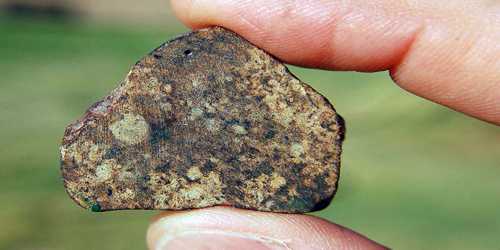
History about Chondrite
Chondrites formed about 4.56 billion years ago as part of the formation of their parent asteroids. They are chemically quite similar to one another and, apart from the most volatile elements (e.g., hydrogen and helium), to the Sun. Since most of the mass of the solar system is in the Sun, the initial composition of the solar system would have been similar to the Sun’s composition. The great age of the chondrites, their primitive chemistry, and the relatively unmodified state of their constituents all suggest that these meteorites retain a record of processes that happened in the solar nebula before and during the phase of planet formation. Nevertheless, the meaning of this record remains to be fully deciphered. The chondrites also contain material, including organic matter and tiny grains that formed around dying stars that predates the formation of the solar system.
Classifications of Chondrite
Chondrites can also be categorized according to their petrologic type, which is the degree to which they were thermally metamorphosed or aqueously altered.
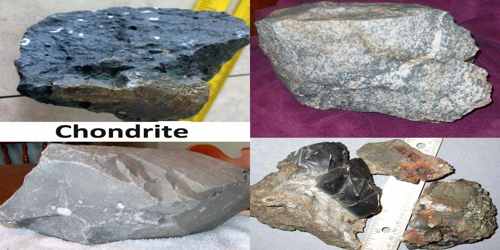
- Ordinary Chondrites: Living up to their namesake, ordinary chondrites are the most commonly found type, accounting for 90 percent of chondrite occurrences and 80 percent of all meteorites reaching Earth. These chondrites do display great differences in their stony makeup, and experts group them into classifications known as meteorite taxonomy. Ordinary chondrites classified with H have the highest iron levels, weighing up to 27 percent their total weight, while those with an L classification have lower iron levels of approximately 23 percent their total weight. On the other hand, chondrite classified with LL denotes a low iron presence of about 20 percent.
- Carbonaceous Chondrites: These groups of chondrites are among the oldest known to humankind. These chondrites are rich in sulfides, oxides, and silicates, along with minerals, water, and carbon. Carbonaceous chondrites are rare and account for only 4 percent of chondrites that land on Earth. Within this chondrite type lie different clans according to which parent body they originate from, and from which part of the solar nebula. These groupings feature classifications such as CI, CM, CV, CO, CK, CR, CH, CB, and C Ungrouped.
- Rumuruti Chondrites: R (Rumuruti type) chondrites are a very rare group, with only one documented fall out of almost 900 documented chondrite falls. They have a number of properties in common with ordinary chondrites, including similar types of chondrules, few refractory inclusions, similar chemical composition for most elements, and the fact that 17O/16O ratios are anomalously high compared to Earth rocks. They contain fewer chondrules than the E chondrites, and appear to come from an asteroid’s regolith.
- Enstatite Chondrites: Enstatite chondrites belong to the E grouping and represent another rare type. What makes them unusual is that their primary chemical makeup shows that they contain an iron content almost completely made of metal sulfide instead of the oxides residing in silicates that one typically finds in other chondrites. These elemental characteristics suggest that the enstatite originated within the inner regions of the solar system, almost entirely devoid of oxygen. A few EH and EL enstatite chondrites also contain the graphite compound, which makes them especially rare since graphite is atypical for igneous rocks formed in low oxygen levels.
Most chondrites contain the anhydrous silicate minerals olivine, orthopyroxene and clinopyroxene, and plagioclase, as well as the nickel-iron minerals kamacite and taenite and the iron sulfide troilite. Some contain claylike hydrous silicates.
Reference:
